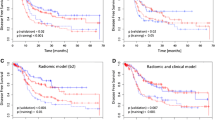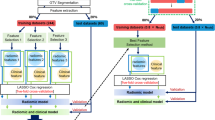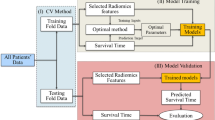Abstract
Purpose
To describe the possibility of building a classifier for patients at risk of lymph node relapse and a predictive model for disease-specific survival in patients with early stage non-small cell lung cancer.
Methods
A cohort of 102 patients who received stereotactic body radiation treatment was retrospectively investigated. A set of 45 textural features was computed for the tumor volumes on the treatment planning CT images. Patients were split into two independent cohorts (70 patients, 68.9%, for training; and 32 patients, 31.4%, for validation). Three different models were built in the study. A stepwise backward linear discriminant analysis was applied to identify patients at risk of lymph node progression. The performance of the model was assessed by means of standard metrics derived from the confusion matrix. Furthermore, all textural features were correlated to survival data to build two separate predictive models for progression-free survival (PFS) and disease-specific survival (DS-OS). These models were built from the features/predictors found significant in univariate analysis and elastic net regularization by means of a multivarate Cox regression with backward selection. Low- and high-risk groups were identified by maximizing the separation by means of the Youden method.
Results
In the total cohort (77, 75.5%, males; and 25, 24.5%, females; median age 76.6 years), 15 patients presented nodal progression at the time of analysis; 19 patients (18.6%) died because of disease-specific causes, 25 (24.5%) died from other reasons, 28 (27.5%) were alive without disease, and 30 (29.4%) with either local or distant progression. The specificity, sensitivity, and accuracy of the classifier resulted 83.1 ± 24.5, 87.4 ± 1.2, and 85.4 ± 12.5 in the validation group (coherent with the findings in the training). The area under the curve for the classifier resulted in 0.84 ± 0.04 and 0.73 ± 0.05 for training and validation, respectively. The mean time for DS-OS and PFS for the low- and high-risk subgroups of patients (in the validation groups) were 88.2 month ± 9.0 month vs. 84.1 month ± 7.8 month (low risk) and 52.7 month ± 5.9 month vs. 44.6 month ± 9.2 month (high risk), respectively.
Conclusion
Radiomics analysis based on planning CT images allowed a classifier and predictive models capable of identifying patients at risk of nodal relapse and high-risk of bad prognosis to be built. The radiomics signatures identified were mostly related to tumor heterogeneity.


Similar content being viewed by others
References
Siegel R, Miller K, Jemal A (2018) Cancer statistics. CA Cancer J Clin 68:7–30
Howlader N, Noone AM, Krapcho M et al (2017) SEER Cancer Statistics Review, 1975–2014, National Cancer Institute. Bethesda, MD, April 2017. https://seer.cancer.gov/csr/1975_2014/. Accessed 1st June 2019
Aberle D, Adams A, Berg C et al (2011) Reduced lung cancer mortality with low-dose computed tomographic screening. N Engl J Med 365:395–409
Padda S, Burt B, Trakul N, Wakelee H (2014) Early-stage non-small cell lung cancer: surgery, stereotactic radiosurgery, and individualized adjuvant therapy. Semin Oncol 41:40–56
Abel S, Hasan S, Horne ZD et al (2019) Stereotactic body radiation therapy in early-stage NSCLC: historical review, contemporary evidence and future implications. Lung Cancer Management 8:1
Timmerman R, Paulus R, Galvin J et al (2010) Stereotactic body radiation therapy for inoperable early-stage lung cancer. JAMA 303:1070–1076
Timmerman R, Paulus R, Pass H et al (2018) Stereotactic body radiation therapy for operable early-stage lung cancer: findings from the NRG oncology RTOG 0618 trial. JAMA Oncol 4:1263–1266
Videtic G, Hu C, Singh A et al (2015) A randomized phase 2 study comparing 2 stereotactic body radiation therapy schedules for medically inoperable patients with stage I peripheral non-small cell lung cancer: NRG oncology RTOG 0915 (NCCTG N0927). Int J Radiat Oncol Biol Phys 93:757–764
Robinson C, DeWees T, El Naqa I et al (2013) Patterns of failure after stereotactic body radiation therapy or lobar resection for clinical stage I non-small-cell lung cancer. J Thorac Oncol 8:192–201
Chi A, Liao Z, Nguyen NP et al (2010) Systemic review of the patterns of failure following stereotactic body radiation therapy in early-stage non-small-cell lung cancer: clinical implications. Radiother Oncol 94:1–11
Foster C, Rusthoven C, Sher D et al (2019) Adjuvant chemotherapy following stereotactic body radiotherapy for early stage non-small-cell lung cancer is associated with lower overall: a national cancer database analysis. Cancer Treat Res 130:162–168
Lambin P, Rios-Velazquez E, Leijenaar R, Carvalho S, van Stiphout R, Granton P et al (2012) Radiomics: extracting more information from medical images using advanced feature analysis. Eur J Cancer 48:441–446
Lambin P, van Stiphout R, Starmans M et al (2013) Predicting outcomes in radiation oncology, multifactorial decision support systems. Nat Rev Clin Oncol 10:27–40
Aerts H, Velazquez E, Leijenaar R, Parmar C, Grossmann P, Carvalho S et al (2014) Decoding tumour phenotype by noninvasive imaging using a quantitative radiomics approach. Nat Commun 5:4006
van Timmeren J, van Elmpt W, Leijenaar R, Reymen B, Monshouwer R (2019) Bussik J er al. Longitudinal radiomics of cone-beam CT images from non-small cell lung cancer ptients: evaluation of the added prognostic value for overall survival and locoregional recurrence. Radiother Oncol 136:78–85
Buizza G, Toma-Dasu I, Lazzeroni M, Paganelli C, Riboldi M, Chang Y et al (2018) Early tumor response prediction for lung cancer patients using novel longitudinal pattern features from sequential PET/CT image scans. Phys Med 54:21–29
de Jong E, van Elmpt W, Rizzo S, Colarieti A, Spitaleri G, Leijenaar R, Jochems A et al (2018) Applicability of a prognostic Ct-based radiomic signature model trained on stage I–III non small cell lung cancer in stage IV non small-cell lung cancer. Cancer Treat Res 124:6–11
Ramella S, Fiore M, Greco C, Cordelli E, Sicilia R, Merone M et al (2018) A radiomic approach for adaptive radiotherapy in non-small cell lung cancer patients. PLoS ONE 13:e207455
Kirienko M, Cozzi L, Antonovic L, Lozza L, Fogliata A, Voulaz E et al (2018) Prediction of diease free survival by PET/CT radiomic signature in non-small cell lung cancer patients undergoing surgery. Eur J Nucl Med Mol Imaging 45:207–217
Kirienko M, Cozzi L, Rossi A, Voulaz E, Antonovici L, Chiti A, Sollini M (2018) Ability of FDG-PET and CT radiomics features to differentiate between primary and metastatic lung lesions. Eur J Nucl Med Mol Imaging 45:1649–1660
Starkov P, Aguilera T, Golden D, Sholtz D, Trakul N, Maxim P et al (2019) The use of texture based radiomics CT analysis to predict outcomes in early stage non-small cell lung cancer with stereotactic ablative radiotherapy. Br J Radiol 92:20180228
Huynh E, Coroller T, Narayan V, Agrawal V, Hou Y, Romano J et al (2016) CT-based radiomic analysis of stereotactic body radiatin therapy patients with lung cancer. Radiother Oncol 120:258–266
Nioche C, Orlhac F, Boughdad S, Reuzé S, Goya-Outi J, Robert C et al (2018) LIFEx: a freeware for radiomic feature calculation in multimodality imaging to accelerate advances in the characterization of tumor heterogeneity. Cancer Res 78:4786–4789
Sollini M, Cozzi L, Antunovic L, Chiti A, Kirienko M (2017) PET Radiomics in NSCLC: state of the art and a proposal for harmonization of methodology. Sci Rep 7:358
Collins G, Reitsma J, Altman D, Moons K (2015) Transparent reporting of a multivariable prediction model for individual prognosis or diagnosis (TRIPOD): the TRIPOD statement. Br Med J 350:g7594
Cozzi L, Franzese C, Fogliata A, Franceschini D, Navarria P, Tomatis S et al (2019) Predicting survival and local control after radiochemotherapy in locally advanced head and neck cancer by means of computed tomography based radiomics. Strahlenther Onkol 195:805–818
Youden W (1950) Index for rating diagnostic tests. Cancer 3:32–35
R Core Team A language and environment for statistical computing. R Foundation for Statistical Computing, Vienna, Austria. https://www.R-project.org/. Accessed 1st June 2019
Huang Y, Liu Z, He L, Chen X, Pan D, Ma Z (2016) Radiomics signature: a potential biomarker for the prediction of disease free survival in early stage (I or II) non-small cell lung cancer. Radiology 281:947–957
van Timmeren J, Carvalho S, Leijenaar R, Troost E, van Elmpt W, de Ruysscher D et al (2019) Challenges and caveats of a multi-center retrospective radiomics study: an example of early treatment response assessment for NSCLC patients using FDG-PET/CT radiomics. PLoS ONE 14:e217536
Yu W, Tang C, Hobbs B, Li X, Koay E, Wistuba I et al (2018) Development and validation of a predictive radiomics model for clinical outcomes in stage I non-small cell lung cancer. Int J Radiat Oncol Biol Phys 102:1090–1097
Bogowicz M, Riesterer O, Ikenberg K, Stieb S, Moch H, Studer G et al (2017) Computed tomography radiomics predicts HPV status and local tumor control after definitive radiochemotherapy in head and neck squamous cell carcinoma. Int J Radiat Oncol Biol Phys 99:921–928
Thawani R, McLane M, Beig N, Ghose S, Prasanna P, Velcheti V, Madabhoshi A (2018) Radiomics and radiogenomics in lung cancer: a review for the clinician. Cancer Treat Res 115:34–41
Larue R, Van De Voorde L, van Timmeren J, Leijenaar R, Berbee M, Sosef M et al (2017) 4DCT imaging to assess radiomics feature stability: an investigation for thoracic cancers. Radiother Oncol 125:146–153
Author information
Authors and Affiliations
Corresponding author
Ethics declarations
Conflict of interest
L. Cozzi acts as Scientific Advisor to Varian Medical Systems and is Clinical Research Scientist at Humanitas Cancer Center. D. Franceschini, F. De Rose, P. Navarria, A. Fogliata, C. Franzese, D. Pezzulla, S. Tomatis, G. Reggiori, and M. Scorsetti declare that they have no competing interests.
Additional information
The authors Davide Franceschini and Luca Cozzi contributed equally to the manuscript.
Caption Electronic Supplementary Material
66_2019_1542_MOESM1_ESM.docx
Figure 1a in the supplementary materials shows examples of tumor volumes for low risk (A) and high risk (B) patients. Table 1a in the shows a summary of the values of the features used in the signatures
Rights and permissions
About this article
Cite this article
Franceschini, D., Cozzi, L., De Rose, F. et al. A radiomic approach to predicting nodal relapse and disease-specific survival in patients treated with stereotactic body radiation therapy for early-stage non-small cell lung cancer.. Strahlenther Onkol 196, 922–931 (2020). https://doi.org/10.1007/s00066-019-01542-6
Received:
Accepted:
Published:
Issue Date:
DOI: https://doi.org/10.1007/s00066-019-01542-6




